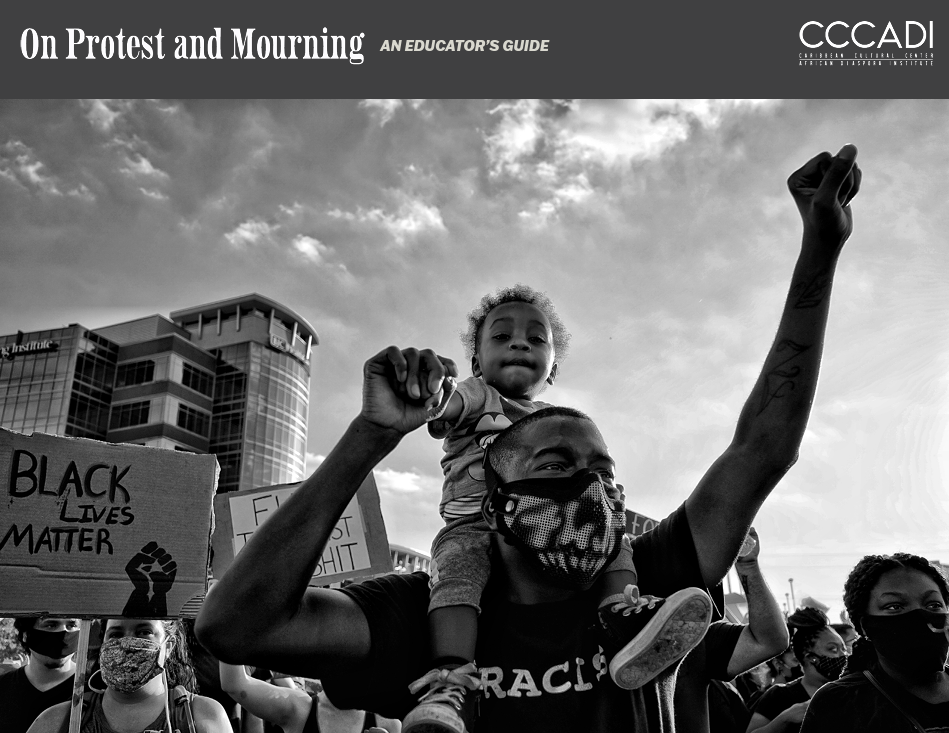EDUCATION GUIDEBOOKS
-

BYENVENI Education Guide
This guide was developed as a resource to support the Caribbean Cultural Center African Diaspora Institute’s exhibition, BYENVENI. The sections and suggested lesson activities below will explore the concepts of the exhibition to support a better understanding of Haiti's history and culture. The guide is broken up into sections, reflective of the exhibition’s galleries - Section I: Lespri, Introduction to Haitian Spirituality; Section II: Tè Nou, How to Define Home? Why Do We Leave Home; Section III: Lakou, Knowledge of the Community; Section IV: Poto Mitan, The Role of the Mother; Section V: Haitian Independence, What’s the Story Behind a Traditional Dish.
-

Rhythm, Bass and Place: Through the Lens
This guide was developed as a resource to support the Caribbean Cultural Center African Diaspora Institute’s newest exhibition, Rhythm, Bass and Place: Through the Lens. The sections and suggested lesson activities will explore the concepts of the exhibition. Section I: The Reflections of Music Overview covers the range of music throughout the Diaspora. Section II: Knowledge of Self and Community, focuses on Hip-Hop’s fifth element and its significance to the culture. Section III: Sampling and Sonic Lineage highlights the art and historical trajectory of making Hip-Hop music. Section IV: What is a Mixtape? explains how Hip-Hop spread with the cassette tape. We invite you to utilize this guide as a resource as you explore the exhibition or after you’ve explored the featured works.
-

The Abyss of the Ocean: Cuban Women Photographers, Migrations & the Question of Race
Our identities are fluid, multifaceted, and ever-changing. Who we are in one person’s company is not the same as when we are in the company of another. Who we were just moments ago is not who we are today nor who we will be tomorrow. When we are true to who we are, we embrace all of our parts in our wholeness.
Throughout Latin American history, European colonizers have reduced Black and Indigenous people from the complexities of their beings to bits and parts. The Abyss of the Ocean explores and challenges how the concept of “Latinidad” has fit Black women, in particular, into stereotypes and rigid roles. Each artist uses her photography to expose and expand these limiting perceptions of Black women.
In the activities that follow, you will learn how art is used to explore, analyze, and challenge traditional history and narratives. You will also explore, analyze, and challenge the traditional histories and narratives of the cultures and communities to which you belong.
-

ON PROTEST AND MOURNING
This guide was developed as a resource for educators to support their planned virtual visit to the Caribbean Cultural Center African Diaspora Institute’s newest exhibition, ON PROTEST & MOURNING. The exhibition overview, suggested pre viewing lesson plans, and suggested exhibit viewing lesson plan activities will assist educators and their students in exploring the exhibition’s key concepts. There will be an opportunity for educators to invite parents/guardians/families to participate to view the exhibit with your class and participate in the discussion.Section One: Educator Preparation is pre work intended to prepare educators on how to talk to students about race and anti-Black violence. Section Two: Anti-Black Violence: Context & History consists of pre visit lesson plans intended to prepare students and educators to view the exhibit. The lessons in section two set the foundation for how to have safe and authentic conversations about race, racism and anti-Black violence. You will explore the definitions of race and racism, the impact of race and racism, the history of anti-Black Violence, the origins of police brutality, youth protest movements, the definitions of grief and mourning and the intersection of protest and mourning. Section Three: On Protest & Mourning: A Virtual Exhibit explores the virtual exhibit ON PROTEST & MOURNING through lesson plans that will connect the exhibit to anti-Black violence occurring in America today. Students will be asked to consider the impact of the art presented in the exhibit and how the art represents protest and mourning in the Black community. Section Four: Additional Resources consists of additional resources for both educators and students to support in furthering your learning as well as mental health resources to support both educators and students.
-

THE COLOR OF POWER
This guide was developed as a resource for educators to support their planned visit to the Caribbean Cultural Center African Diaspora Institute’s newest exhi- bition, THE COLOR OF POWER: HEROES, SHEROES, & THEIR CREATORS on view from November 16, 2019—June 13, 2020. The overview, suggested lesson plan activities, and interactive viewing questions will assist educators and their stu- dents in exploring the exhibition’s impressionable imagery and key concepts. There are interdisciplinary curriculum linkages, such as Visual Arts, Social Studies, and English Language Arts. Section I, The African Diaspora in Comic Books: A Blackverse Overview provides background information on the exhibition’s inspirations, as well as highlights on the underbelly of comic book history. Section II, The Color of Power: Exploring the Blackverse provides educators with key viewing questions as the narratives are read, and their accompanying images are seen. Section III, Additional Resources is comprised of suggested lesson plan activities, a glossary, and bibliography with online weblinks for further research and reference.
-

RACE, MYTH, ART AND JUSTICE
This guide was developed as a resource for educators to support their planned visit to the Caribbean Cultural Center African Diaspora Institute’s newest exhibition, RACE, MYTH, ART, and JUSTICE on view from November 15, 2018– June 15, 2019. The exhibition overview, guided inquiry sections, and suggest- ed lesson plan activities will assist educators and their students in exploring the exhibition’s key concepts. There are interdisciplinary curriculum linkages, such as Visual Arts, Social Studies, the Moving Image, and English Language Arts. Section I, Race as Myth provides background on the exhibition’s images which challenge historic notions of “race” and its hierarchical assignments of privilege. Section II, Art: The Invisible Made Visible provides educators with key viewing questions for reflection on how art has been used to give visibility to those most affected by a Black race status. Section III, Justice: Looking at Socially Responsive Art looks at art created in response to societal inequities. Section IV, Additional Resources is comprised of suggested lesson plan activities, a glossary, and bibliography, with online weblinks for further research and reference.
-

DEFEND PUERTO RICO
This guide was developed as a resource for educators to support their planned visit to the Caribbean Cultural Center African Diaspora Institute’s newest exhibition, DEFEND PUERTO RICO on view from February 15, 2018–June 2018. The historical project overview, suggested lesson plan activities, and interactive viewing questions will assist educators and their students in exploring the exhibition’s key concepts. There are interdisciplinary curriculum linkages, such as Visual Arts, Social Studies, and English Language Arts. Section I, Historical Project Overview provides background on the exhibition’s inspira- tions and direct actions happening on the island. Section II, DEFEND PUERTO RICO: Exploring the Exhibition provides educators with key viewing questions as the narra- tives and images are heard and seen. Section III, Additional Resources is comprised of suggested lesson plan activities, a glossary, and bibliography with online weblinks for further research and reference.
-

HOME, MEMORY, AND FUTURE
This guide was developed as a resource for educators to support their planned visit to the Caribbean Cultural Center African Diaspora Institute’s inaugural exhibition, HOME, MEMORY, AND FUTURE on view from October 2016—April 2017. The historical information, suggested lessons, and guided inquiry sections will assist educators, and students in their explorations with concepts of HOME through interdisciplinary curriculum linkages such as Visual Arts, Social Studies, and English Language Arts. Section I, Harlem: An Historical Overview provides abbreviated historical background, which begins with the Lenni Lenape peoples who settled the region over 9,000 years ago, along with an accompanying timeline of significant events which have punctuated the evolution and existence of Harlem as a community. Section II, Exploring the Concept of HOME assists educators with looking and inquiry questions for more meaningful exploration of the exhibition. Section III, Additional Resources is comprised of suggested lesson plans, a glossary, bibliography, and online web-links for further research and reference.
-

LIMINAL SPACE
Description goes hereThis family guide was created with young audiences in mind. ages eight to twelve for exploring the Caribbean Cultural Center African Diaspora lnstitute's (CCCADI) new and exciting exhibition, Liminal Space. This exhibition features the artwork of sixteen Guyanese artists. Children with adults can together use this guide to explore and document their art experience through viewing, writing, and fun activities.
We believe learning about the history and art of this African Diaspora community will help you to better understand Just how vaned and brilliant our cultures and creative expressions are around the world.
As you walk through the exhibition, be inspired. Explore and embrace your creativity and brilliance!
